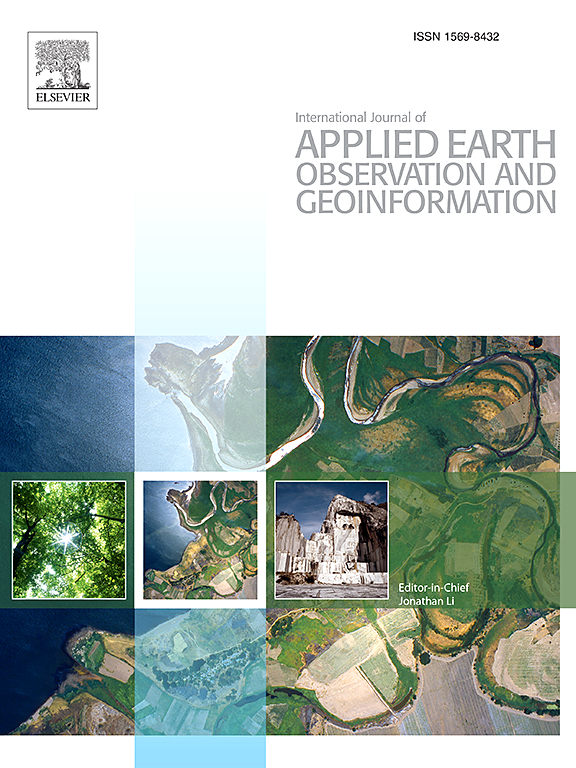insar辅助板岩边坡深部重力变形(DSGSD)填图及分区研究
IF 8.6
Q1 REMOTE SENSING
International journal of applied earth observation and geoinformation : ITC journal
Pub Date : 2025-06-04
DOI:10.1016/j.jag.2025.104641
引用次数: 0
摘要
深部重力边坡变形(DSGSD)是一种在山体尺度上运动速度缓慢的岩体损耗过程。在台湾,由于其固有的解理特征,在台湾主干岭板岩带中,常发现单晶硅矿。板岩边坡在发生DSGSD过程时,会积累较大的变形位移,形成岩滑。在这种情况下,边坡运动可能会从以解理方向为主转变为以下坡方向为主,如著名的庐山北坡。本研究旨在检测dsgsd,并在区域尺度上划分当今的边坡活动。基于多时相干涉合成孔径雷达(MT-InSAR)技术,提出了一种类热点的DSGSD制图与区划方法。该分析应用于2018年至2020年以台湾北京地区为中心在上升和下降轨道上获得的哨兵1号雷达数据。结合LiDAR地形数据和光学图像,我们识别出5个具有较高变形运动学的DSGSD域,其中包括一个尚未被相关政府机构作为DSGSD进行调查/监测的站点。此外,我们计算了两个采集的MT-InSAR数据的分解位移向量,建立了每个区域的几何和运动学模型。结合钻孔解释、倾角仪数据和简化的力学模拟,该模型描述了观测到的dsgsd的现今移动现象和驱动机制。总的来说,MT-InSAR技术可以帮助对石板坡上的DSGSD进行区域性的危害评估,包括制图和分区。研究结果还强调了insar辅助观测在了解短期运动运动学和制定特定地点监测策略方面的潜力。本文章由计算机程序翻译,如有差异,请以英文原文为准。
InSAR-aided mapping and zonation of deep-seated gravitational slope deformation (DSGSD) in slate slopes
Deep-seated gravitational slope deformation (DSGSD) is a rock mass wasting process featuring a slow movement rate at the mountain scale. In Taiwan, DSGSD has often been reported in the slate belt of Taiwan’s backbone Range because of the inherent cleavage characteristic. When a slate slope undergoes the DSGSD process, it can accumulate large deformation displacements and transform into a rockslide. In this circumstance, the slope movement could change from the cleavage orientation-dominated to the downslope direction, such as in the famous case of the Lushan North Slope. A critical issue for Taiwan’s authority in dealing with hazards associated with DSGSD is the efficient identification of hidden active DSGSD within the wide mountainous area for further detailed investigation/monitoring. This study aims to detect DSGSDs and zonate the present-day slope activity at the regional scale. Based on the Multi-temporal Interferometric Synthetic Aperture Radar (MT-InSAR) technique, we propose a hot-spot-like DSGSD mapping and zonation approach. The analysis was applied to Sentinel-1 radar data acquired in ascending and descending orbits between 2018 and 2020 centered on the Chingjing region, Taiwan. Combined with LiDAR terrain data and optical images, we recognized five DSGSD domains with higher deformation kinematics, which include a site that has yet to be investigated/monitored as DSGSD by relevant government agencies. In addition, we calculated the decomposed displacement vectors from two acquisition MT-InSAR data to establish each domain’s geometrical and kinematical model. Combined with borehole interpretation, inclinometer data, and simplified mechanical simulation, the models characterize the present-day moving phenomena and driving mechanisms for the observed DSGSDs. Overall, the MT-InSAR technique can aid the region-wide hazard assessment for the DSGSD in slate slopes regarding mapping and zonation. The results also highlight the potential of InSAR-assisted observation for understanding short-term movement kinematics and formulating a site-specific monitoring strategy.
求助全文
通过发布文献求助,成功后即可免费获取论文全文。
去求助
来源期刊

International journal of applied earth observation and geoinformation : ITC journal
Global and Planetary Change, Management, Monitoring, Policy and Law, Earth-Surface Processes, Computers in Earth Sciences
CiteScore
12.00
自引率
0.00%
发文量
0
审稿时长
77 days
期刊介绍:
The International Journal of Applied Earth Observation and Geoinformation publishes original papers that utilize earth observation data for natural resource and environmental inventory and management. These data primarily originate from remote sensing platforms, including satellites and aircraft, supplemented by surface and subsurface measurements. Addressing natural resources such as forests, agricultural land, soils, and water, as well as environmental concerns like biodiversity, land degradation, and hazards, the journal explores conceptual and data-driven approaches. It covers geoinformation themes like capturing, databasing, visualization, interpretation, data quality, and spatial uncertainty.
 求助内容:
求助内容: 应助结果提醒方式:
应助结果提醒方式:


